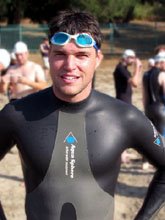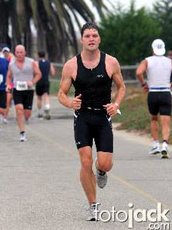 When I decided to do a triathlon last season, the thing that scared me most was the swim, probably because prior to January 2005, the longest distance I'd ever swum was at a swimming hole in New Hampshire. That particular odyssey was accomplished by flailing, gasping, splashing around like a wounded harp seal, nearly drowning, and, finally, utterly spent on the swimming dock 12 yards from shore. No one on the dock was the least bit impressed by my Spitzian efforts, least of all my wife, who pretended she didn't know me, even as I pleaded with her to call 911 to reboot my arrested cardio-pulmonary system.
When I decided to do a triathlon last season, the thing that scared me most was the swim, probably because prior to January 2005, the longest distance I'd ever swum was at a swimming hole in New Hampshire. That particular odyssey was accomplished by flailing, gasping, splashing around like a wounded harp seal, nearly drowning, and, finally, utterly spent on the swimming dock 12 yards from shore. No one on the dock was the least bit impressed by my Spitzian efforts, least of all my wife, who pretended she didn't know me, even as I pleaded with her to call 911 to reboot my arrested cardio-pulmonary system.Since then, though, and to my complete surprise, I now love swimming, and I consider it the easiest part of any triathlon I've done. It's still a great -- and blessedly less life-threatening -- workout, and since the water absorbs impact and prevents lightning-fast muscle contractions, even I am unlikely to injure myself doing it. Once you become reasonably competent at it, swimming also has a Zen quality: like T'ai Chi, there's a rhythmic, lyrical flow to the movement, and you can get so you feel very much at home in the water, as if you are dancing on top of it.
 Before you get to that point, however -- and I'm hardly an expert at it -- you've got to do a little bit of work on technique. Take heart though: unlike, say, playing Chopin preludes on a Steinway, swimming is fairly easy to learn. There are really just a handful of principles that can take you from dog-paddler to barracuda in a few easy steps.
Before you get to that point, however -- and I'm hardly an expert at it -- you've got to do a little bit of work on technique. Take heart though: unlike, say, playing Chopin preludes on a Steinway, swimming is fairly easy to learn. There are really just a handful of principles that can take you from dog-paddler to barracuda in a few easy steps.What you've got to remember from the outset is that very few people are BORN swimmers. Sure, a few million years back our distant ancestors may have had fins and gills, but we've been land-dwellers for so long that our instincts about what to do in the water are often more likely to drown us than get us to the next buoy. So learning to swim is about undoing a few inborn fears and impulses and learning to trust and love the water.
The tips below are on swimming the crawl, or freestyle, stroke. If you want to swim backstroke, or butterfly, or breaststroke, go ask someone else, because, well, I don’t know how to do them. I just don't. There, I said it. I feel better.
1) SWIM HORIZONTAL. Most of us landlubbers think that swimming is like walking through water, and so we swim more or less vertically, with our heads out of the water and our feet reaching more or less downwards. That impulse stems from the perfectly logical premise that as mammals, we can't breathe underwater and submerging our faces in the water will just cause sputtering, embarrassment and possible death.
But swimming vertically is just about the least efficient way to move through the water. Because water is so much more dense than air, your position as you move through it is vitally important to preserving energy. Use the image that you want to swim through as small a hole in the water as you can -- meaning, swim horizontally. Since your chest is filled with air and wants to float, you actually need to focus on pressing the chest and head DOWN into the water. The result will be that the butt lifts UP, which is exactly what you want to happen. The sensation will be like swimming downhill.
 2) SWIM LONG. When you watch a world champion swimmer like Michael Phelps in the pool, you'll see that it doesn't take him very many strokes to get across the pool, whereas we mortals flail and flail, exhaust ourselves, and are still only halfway down our lane. That's because Phelps swims LONG: his yardage per stroke is phenomenally high.
2) SWIM LONG. When you watch a world champion swimmer like Michael Phelps in the pool, you'll see that it doesn't take him very many strokes to get across the pool, whereas we mortals flail and flail, exhaust ourselves, and are still only halfway down our lane. That's because Phelps swims LONG: his yardage per stroke is phenomenally high.Take a page from Phelps' book and learn to swim long by reaching and stretching as far in front of you as you can with each stroke. Then gather -- or "catch" as the pros say -- as much water beneath your wings as you can before pulling through, and finally pushing the water back behind you. Your stroke shouldn't begin until your arm is fully reaching over past your head and shouldn't end until your hand is down by your mid-thigh. Think of yourself as a huge turbine, consuming great quantities of water beneath you with each stroke.
3) BREATHE EASY. How often a swimmer breathes is a very individual matter. I was coached to breathe with each stroke, each time my left arm came out of the water to reach for another stroke. "Bilateral breathing," that is, breathing on every other side every third stroke, comes highly recommended by some coaches, and has the advantages of working both sides of the body equally, saving some energy, and increasing your awareness of what's around you during your swim. All good. If you can swing it, and don't find yourself gasping for air every five strokes like I do when I attempt bilateral breaths, go for it. I agree in theory that it's probably a better way to go, but I've never been able to manage it.
 The universal truth -- for bilateral porpoises and unilateral guppies like me -- is that you should breathe as efficiently as possible. Meaning, don't lift the whole head out of the water, and don't twist your head behind you like Linda Blair in The Exorcist. Just turn the head along with the arm and shoulder that's coming out of the water, just far enough to clear your mouth, take in a nice mouthful of refreshing air, and swing the head easily back down into the water. The key is to breathe without losing your basic, horizontal and extremely hydrodynamic positioning in the water.
The universal truth -- for bilateral porpoises and unilateral guppies like me -- is that you should breathe as efficiently as possible. Meaning, don't lift the whole head out of the water, and don't twist your head behind you like Linda Blair in The Exorcist. Just turn the head along with the arm and shoulder that's coming out of the water, just far enough to clear your mouth, take in a nice mouthful of refreshing air, and swing the head easily back down into the water. The key is to breathe without losing your basic, horizontal and extremely hydrodynamic positioning in the water.4) KICK FOR FLOTATION. This morning I was in the pool and tried to get across the pool using only my legs, arms laid across a kickboard. Crikey, that was tough. By the end of 50 yards, which took me forever, the glutes were on fire and I had drowning anxiety. The lifeguard actually put down his iPod and was poised to dive in after me.
The point? Kicking doesn't add that much to your forward propulsion. In triathlon we are actually discouraged from kicking because it can tire out lower-body energy that is better spent on the biking and running to come. I'm not advocating that. But I am saying that your kick should be very relaxed and easy (are you sensing a pattern here?), with the ankles flopping like fins, not rigid like paddles. Legs should be more or less straight, and don't go for too much splash. Use the kick to help keep you horizontal, not like an outboard motor.
I realize that many readers will curse me for writing about swimming at the end of the summer, but when the cold months descend and you head indoors for your workouts anyway, swimming is a great option. It's a terrific upper-body toner, and it's easy on the joints, so you can do some laps some day when you just don't feel like hitting the bench press and the lat pulldown for the millionth time this month. Like you usually do... right?
Enjoy, and have a great week--
Andrew




2 comments:
I had a very similar progression with my swimming. I now love the swim leg of triathlon, even if I know I can still improve in it. My first swim I thought I was going to drown after 20 yards, now I feel quite comfortable in water and feel like I can swim as long as I want.
One of the things I think is key is head position. I see so many people with their heads plowing through the water, half in and half out. Feeling water over the back of your head reminds you that you are efficient in the water.
You might want to check out Total Immersion, as I will give them credit for teaching me how to swim in triathlons. And you are right, the winter is the perfect time to retool your swimming to get more comfortable. It isn't about logging thousands of laps, it is about becoming more efficient.
Great content! As a lifelong, hardcore swimmer its hard to explain it in writing but you've done a great job!
Post a Comment